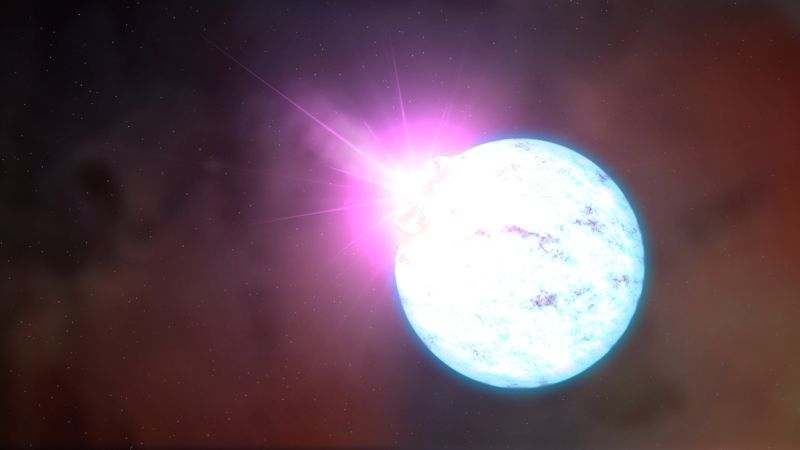
Immediately after the Big Bang, the Universe's matter was incredibly dense and rippled with random fluctuations. Is it possible that some portions of it reached densities high enough to collapse into black holes?
The idea of primordial black holes has been kicking around in theoretical circles for a while, in part because they could provide much of the dark matter that seems to dominate the Universe's large-scale structures. But testing for their existence requires some sort of consequence that we could detect, and the theorists have largely come up short there. But now, a team of three physicists writing in Physical Review Letters has come up with a rather intriguing consequence: these black holes could swallow a neutron star that, under the right conditions, would spit out heavy elements.
Truth or consequences
Two things could distinguish primordial black holes from those formed in the collapse of a massive star. One is that they could be nearly any mass, from less than the mass of a star up to thousands of times heavier than anything formed during a supernova. The heavier end of the spectrum is appealing, since it could explain how supermassive black holes appeared so quickly (in astronomical terms) after the Universe's birth.
The second feature is that primordial black holes were present early in the Universe's history. The influence of dark matter is apparent long before the Universe formed any stars, which appear to be a necessary precursor for black holes that formed after the Universe started to spread out. Since they were present early, primordial black holes could account for a sizable percentage of the dark matter, though various studies have put some constraints on how much.
The problem is that we can't examine either of these issues in enough detail to know whether primordial black holes exist. So, while these objects remain physically plausible, there hasn't been any consequences to their existence that we can actually search for in the present-day Universe.
Unless, of course, the new paper has it right. In it, its authors describe the rather unusual consequences of a primordial black hole running into an equally exotic object: a rapidly spinning neutron star.
Meet the neutrons
Imagine a sphere the width of Manhattan, spinning so rapidly that it completes a rotation in a matter of milliseconds. Now drop a black hole onto it. What happens?
That's the fundamental question the paper addresses. Black holes have fundamental limits on how quickly they can swallow matter, which means that the neutron star wouldn't be immediately destroyed, even if the two make contact. Instead, the black hole's slow feeding would allow it to settle at the center of the neutron star and start slowly devouring it from within.
As the black hole continued to feed, the neutron star would contract. Conservation of angular momentum would then cause it to rotate faster—and remember, this thing is already moving blindingly fast. In the end, it's possible to get one of these rotating fast enough that the surface near the equator will reach escape velocity. As much as 10 percent of the Sun's mass of neutron-rich material would be flung out into space.
Obviously, a mass of neutrons isn't stable under normal conditions, and this material would rapidly undergo reactions to convert itself to atoms. But the authors conclude that the results would be heavy, neutron-rich atomic nuclei. And that's interesting. Heavier nuclei are thought to be formed through something called the r-process, named for the rapid accumulation of neutrons. This requires them to be bombarded with neutrons so fast that the atom doesn't have time to rearrange itself in response to one before a second is absorbed. When the rearrangement reaction finally takes place, there are enough protons and neutrons around to form a heavy element.
Imagine a sphere the width of Manhattan, spinning so rapidly that it completes a rotation in a matter of milliseconds. Now drop a black hole onto it. What happens?
Although it's generally thought that a supernova creates conditions where the r-process can take place, scientists are still trying to work out whether that's actually the case. But the paper in Physical Review Letters argues that we don't need a supernova to form these heavy elements. It argues that the distribution of heavy elements in the Universe is roughly in line with what you'd expect from the primordial black hole/neutron star production route.
In fact, the writers argue that this mechanism can clear up all sorts of astronomical mysteries, from the mechanism for producing non-repeating fast radio bursts, to kilonovas, to our galaxy's production of antimatter. Plus the black holes themselves could account for about 10 percent of the Universe's dark matter.
But the nice feature is that it makes a prediction. If we were to observe a nearby kilonova or fast radio burst, gravitational wave detectors might sense a disturbance, but that disturbance wouldn't be accompanied by the normal waves caused by black holes spiraling into each other—for obvious reasons, given that the black hole is already inside its partner. All we have to do is wait a few years for a few more detectors to come online, then wait however long it takes for one of these events to happen within their detection radius.
Physical Review Letters, 2017. DOI: 10.1103/PhysRevLett.119.061101 (About DOIs).
reader comments
52